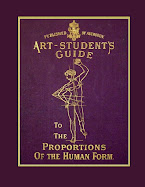The skeletons are derived from Albinus' engravings. Compare them to these two images from The Art Student's Guide to the Bones and Muscles of the Human Body and Lessons on Foreshortening
Sunday, January 31, 2010
Anatomy from the 1889 Encyclopedia Britannica
The skeletons are derived from Albinus' engravings. Compare them to these two images from The Art Student's Guide to the Bones and Muscles of the Human Body and Lessons on Foreshortening
Saturday, October 10, 2009
DIE GESTALT DES MENSCHEN - Joseph Meyer - Meyers Großes Konversations-Lexikon
 Link to the image. Another image.
Link to the image. Another image. Link to the image..
Link to the image..These are images from Joseph Meyer's encyclopedia Meyers Konversations-Lexikon. The encyclopedia is available in facsimile form and search-able form at Zeno.org.
These illustrations show the forms of man and woman using a proportional system of the time which illustrated proportions through a series of points connecting the main features of the body.
From Wikipedia:
Joseph Meyer (May 9, 1796, Gotha, Germany - June 27, 1856, Hildburghausen, Germany) was a German industrialist and publisher.
Meyer was educated as merchant in Frankfurt am Main. He went to London in 1816, but returned to Germany in 1820 after business adventures and stock speculations fell through. Here he invested in enterprises like textile-trade (1820-24), mining industry and railways in the thirties and forties of the 19th century, but with limited results.
Meyer operated very successfully as a publisher, employing a system of serial subscription to publications, which was new at that time. To this end he founded the company "Bibliographisches Institut" in Gotha in 1826, which issued several editions of the Bible, works of classical literature ("Miniatur-Bibliothek der deutschen Classiker", "Groschen-Bibliothek"), atlases, the world in pictures on steel engravings ("Meyers Universum", 1833-61, 17 volumes in 12 languages with 80,000 subscribers all over Europe), and an encyclopaedia, ("das Grosse Conversations-Lexikon für die gebildeten Stände"; see Meyers Konversations-Lexikon, 1839-55, 52 volumes).








Another image shows the human form in art.
 Link to the image.
Link to the image.This one shows the anatomy of the human skeleton:

This one shows the muscles of the human body.

Link to the image.
Link to another post with anatomical images from the encyclopedia.
From Amazon.com

Die Gestalt des Menschen in der Kunst und im Spiegel der Wissenschaft (German Edition)

Studien zur Gestalt des Menschen.
Sunday, July 5, 2009
The Art Student's Guide to the Bones and Muscles of the Human Body: and Lessons on Foreshortening

The Art Student's Guide to the Bones and Muscles of the Human Body and Lessons on Foreshortening is available as a download from Figure-Drawings.com, and as a printed book from Amazon.com
Johann Gottfried Schadow was a talented neo-classical sculptor working in Berlin in the late eighteenth and early nineteenth centuries. He is famous for the quadriga on the Brandenburger Tor and the bust of Friederike von Preußen.

He became director of the Royal Academy of Art in Berlin in 1816 and this book is his first work dedicated to the instruction of his students in the basic anatomy of the human body. He used the prints of Albinus as a starting point and developed clear images of the bone structure and the muscular structure of the human body so that artists and sculptors would have a firm footing as they pursued their craft.
To these plates he added three plates on human proportions, a comparison of heads of youth and adult and old age, and a comparison of male and female, a second plate of typical proportions of the human form, and a third on the proportions of ideal form using classical Greek sculpture as the examples.

A third section is a careful analysis of the human head seen from various angles using the techniques of Albrecht Dürer, Jean Cousin and Johann Preissler.
The book was a revelation to students when first published in 1830, was still in use enough to be republished in 1892 and I think today's students of the human form will find it newly valuable for today's art and new media.

 Human skeleton from the book.
Human skeleton from the book. Muscles of the head from the book.
Muscles of the head from the book. Muscles of the body from the book.
Muscles of the body from the book.

Heads by Albrecht Dürer and Jean Cousin.
He expanded on the plates on proportion and added 27 more plates to make his second book for students titled in English The Sculptor and Art Student's Guide to the Proportions of the Human Form or in the original German, Atlas Zu Polyclet Oder Von Den Maassen Des Menschen Nach Dem Geschlechte Und Alter.
Books at Amazon.com:
The Art Student's Guide to the Bones and Muscles of the Human Body: and Lessons on Foreshortening
The Art Student's Guide To The Proportions Of The Human Form
Kunstwerke und Kunstansichten: Ein Quellenwerk zur Berliner Kunst- und Kulturgeschichte zwischen 1780-1845 (German Edition)


An example of the classical sculpture the Venus de Medici and Dr. Schadows analysis of it.

This last image is that of a student working in the atelier of Dr. Schadow drawn by the student Emil Bendeman, in 1836.
Related posts:
The Sculptor and Art Student's Guide to the Proportions of the Human Form
Johann Gottfried Schadow - Die Zeichnungen
The Art Student's Guide to the Proportions of the Human Form
Related Books:

Albinus on Anatomy

Anatomical Plates Of The Bones And Muscles: Diminished From Albinus, For The Use Of Students In Anatomy, And Artists : Accompanied By Explanatory Maps

Anatomical Plates Of The Bones And Muscles: Diminished From Albinus For The Use Of Students In Anatomy And Artists (1807)

The Anatomical Plates of Pietro da Cortona 27 Baroque Masterpieces
Related book available as an e-book, soon available at Amazon.com:
The Art Student's Guide to External Anatomy























